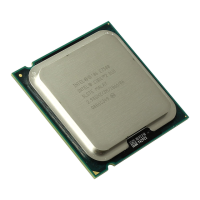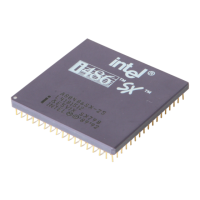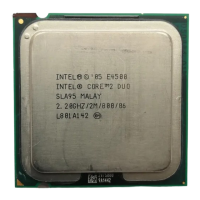Intel
®
Core
TM
2 Duo E6400, E4300, and Intel
®
Pentium
®
Dual-Core E2160 Processor
October 2007 TDG
Order Number: 315279 -003US 19
Processor Thermal/Mechanical Information—Intel
®
Core
TM
2 Duo E6400, E4300, and Intel
®
Pentium
®
Dual-Core E2160 Processor
2.4 System Thermal Solution Considerations
2.4.1 Chassis Thermal Design Capabilities
The Intel reference thermal solution for PICMG 1.3 chassis assumes that the chassis
delivers a maximum TA of 38-40°C with 15-25 CFM of airflow at the inlet of the
processor heatsink.
2.4.2 Improving Chassis Thermal Performance
The heat generated by components within the chassis must be removed to provide an
adequate operating environment for both the processor and other system components.
Moving air through the chassis brings in air from the external ambient environment and
transports the heat generated by the processor and other system components out of
the system. The number, size and relative position of fans and vents determine the
chassis thermal performance, and the resulting ambient temperature around the
processor. The size and type (passive or active) of the thermal solution and the amount
of system airflow can be traded off against each other to meet specific system design
constraints. Additional constraints are board layout, spacing, component placement,
acoustic requirements and structural considerations that limit the thermal solution size.
For more information, refer to the Thin Electronics Bay specification at the following
web site: www.ssiforum.org.
In addition to passive heatsinks, fan heatsinks and system fans are other solutions that
exist for cooling integrated circuit devices. For example, ducted blowers, heat pipes and
liquid cooling are all capable of dissipating additional heat. Due to their varying
attributes, each of these solutions may be appropriate for a particular system
implementation.
To develop a reliable, cost-effective thermal solution, thermal characterization and
simulation should be carried out at the entire system level, accounting for the thermal
requirements of each component. In addition, acoustic noise constraints may limit the
size, number, placement and types of fans that can be used in a particular design.
To ease the burden on thermal solutions, the Thermal Monitor feature and associated
logic have been integrated into the silicon of the processor. By taking advantage of the
Thermal Monitor feature, system designers may reduce the thermal solution cost by
designing to TDP instead of maximum power. Thermal Monitor attempts to protect the
processor during sustained workload above TDP. Implementation options and
recommendations are described in Section 4.
2.4.3 Summary
In summary, considerations in heatsink design include:
• The local ambient temperature TA at the heatsink, which is a function of chassis
design.
• The thermal design power (TDP) of the processor, and the corresponding maximum
TC as calculated from the thermal profile. These parameters are usually combined
in a single lump cooling performance parameter, Ψ
CA
(case to air thermal
characterization parameter). More information on the definition and the use of Ψ
CA
is given in section 3.1.
• Heatsink interface to IHS surface characteristics, including flatness and roughness.
• The performance of the thermal interface material used between the heatsink and
the IHS.
• The required heatsink clip static load, between 18 lbf to 70 lbf throughout the life of
the product (Refer to Section 2.1.2.2 for more information).

